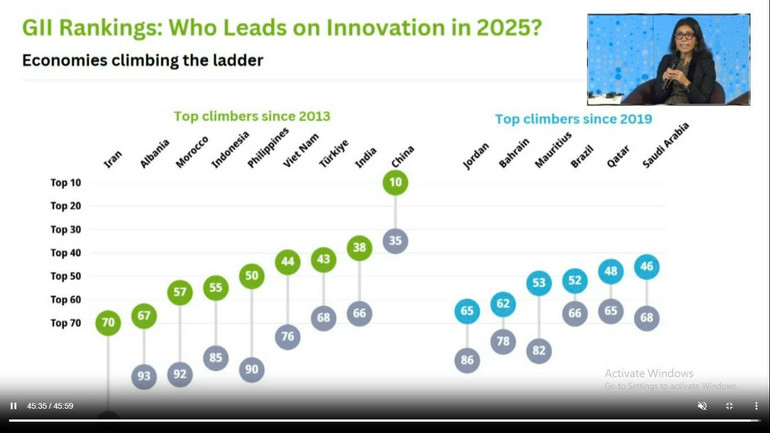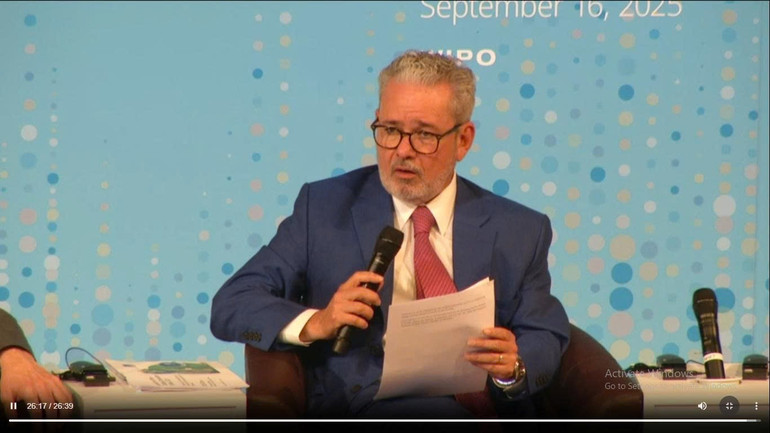
After decades of steady growth, investment in research and innovation finance is losing momentum, according to WIPO. In 2024, global research and development (R&D) growth slowed to its lowest level since 2010. Venture capital funding remains sluggish, falling for the third consecutive year.
But innovation doesn't stand still, with new breakthroughs happening all over the world . From green supercomputers and artificial intelligence, to smarter batteries, faster internet and better cancer care.
Against this backdrop, among the 139 countries and economies ranked, Switzerland leads the Global Innovation Index (GII) 2025, followed by Sweden, the US, South Korea and Singapore. Other economies are catching up. China entered the top 10 for the first time. India, Turkey, Vietnam, the Philippines, Indonesia and Morocco are growing rapidly over time.

Other countries such as Brazil, Malawi, Senegal, Thailand, Tunisia, Uzbekistan and Rwanda are outperforming in innovation relative to their level of development. Meanwhile, regions such as North Africa and West Asia, especially the Middle East, are growing strongly. Innovation is more diverse than ever.
Although Vietnam did not move up the rankings, it made remarkable efforts in many indicators. We continued to improve in innovation input, moving up 3 places compared to 2023, from 53 to 50.
Vietnam maintains its 2nd position in the group of lower middle-income countries. The lower middle-income country ranked above Vietnam is India at 38th. In addition, there are 3 upper middle-income countries ranked above Vietnam (China ranked 10th, Malaysia ranked 34th, Türkiye ranked 43rd), the rest of the countries ranked above Vietnam are all industrialized countries, in the high-income group, with a high ratio of spending on research and development/GDP. In the ASEAN region, Vietnam surpasses Thailand, ranking 3rd after Singapore and Malaysia.
In the WIPO GII 2025 Report, Vietnam was recognized by WIPO as one of the 9 middle-income countries with the fastest improvement in rankings since 2013 (including China, India, Turkey, Vietnam, Philippines, Indonesia, Morocco, Albania and Iran).
Vietnam is also one of two countries that hold the record of having outperformed its development level for 15 consecutive years (including India and Vietnam). For 15 consecutive years, Vietnam has consistently had higher innovation results than its development level, demonstrating its efficiency in converting input resources into innovative outputs. Vietnam is one of three countries (China, Vietnam, Ethiopia) with the fastest labor productivity growth rate in the period 2014-2024.
For the first time, Vietnam has risen to the top of the world in the "Export of Creative Goods" index. Together with "Import of High Technology" and "Export of High Technology", these are three spearheads that affirm Vietnam's position on the global technology map.
Vietnamese universities are not attractive to international students.
However, the GII 2025 report also points out weaknesses that Vietnam needs to improve.

In terms of institutions, Vietnam needs to continue to focus on improving the index of quality of legal regulations (ranked 95) and effectiveness of law enforcement (ranked 67).
Regarding education , Vietnam's education spending decreased by 10 places, down to 116th. The high school student/teacher ratio decreased by 5 places, ranking 107th. The foreign student ratio continued to decrease by 3 places, ranking 108th, showing that universities in Vietnam are still not attracting many international students to study and research.
Regarding infrastructure, although there was a slight improvement, the indicators of "ICT Access" and "ICT Use" both decreased. The group of indicators on ecological sustainability also decreased sharply, especially the "Ratio of low-carbon energy sources" index, which dropped 12 places, a wake-up call for Vietnam's commitment to sustainable development.
Regarding the ability to absorb knowledge and innovate in the service sector, Vietnam's "Import of ICT services" index is near the bottom of the table (133/139), while the "Export of ICT services" and "Copyrights" indexes are also low. The number of scientific and technical articles published is ranked 105, down 8 places.
Regarding investment, the venture capital indexes have not improved, leading to the investment index group falling 12 places, ranking 62nd. In addition, the microcredit index for production and business ranked 58th, down 2 places.
Regarding Creative Products, the creative industry has shown positive signs in recent years, but some low-ranking indicators need to be improved, including the Cultural and Creative Services Export Index (% of total trade) ranked 95, down 14 places; the National Feature Films produced/1 million people aged 15-69 ranked 87, down 11 places.
Every year, the World Intellectual Property Organization (WIPO) publishes the Global Innovation Index (GII). This is a prestigious toolkit for assessing national innovation capacity in the world, reflecting the socio-economic development model based on science, technology and innovation of countries. Through this, countries can see the overall picture as well as their strengths and weaknesses.
For this reason, the GII is now used by many governments as an important reference tool for state management of science, technology and innovation, as well as for developing science, technology and innovation policies.
In Vietnam, in recent times, the Government has used this index as one of the important management tools and has assigned ministries, agencies and localities to be responsible for improving the index. In particular, the Ministry of Science and Technology is assigned to be the focal point for monitoring and general coordination. From 2017 to present, Vietnam's GII index has continuously improved, increasing from 59th (in 2016) to 44/139 (in 2025) countries and economies.
Source: https://nhandan.vn/bao-cao-chi-so-doi-moi-sang-tao-toan-cau-gii-2025-viet-nam-giu-vung-vi-tri-44139-post908516.html







![[Photo] General Secretary To Lam attends the 1st Congress of the Central Party Committee of the Fatherland Front and Central Mass Organizations](https://vphoto.vietnam.vn/thumb/1200x675/vietnam/resource/IMAGE/2025/9/23/2aa63d072cab4105a113d4fc0c68a839)


















![[Photo] Prime Minister Pham Minh Chinh chairs the first meeting of the Central Steering Committee on housing policy and real estate market](https://vphoto.vietnam.vn/thumb/1200x675/vietnam/resource/IMAGE/2025/9/22/c0f42b88c6284975b4bcfcf5b17656e7)

































































Comment (0)